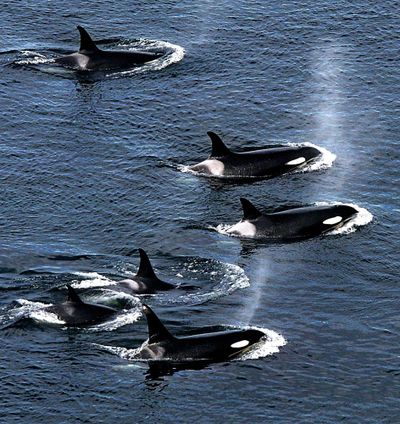Study: Northwest killer whales shrinking in size – and so are their prey, chinook salmon

SEATTLE – Hungry young orcas grow up to be stunted orcas, new research shows, revealing that salmon run downturns can have lifelong effects.
The findings, published last month in the peer-reviewed scientific journal Endangered Species Research, were based on aerial drone photos of whales in both the southern and northern resident orca populations.
The photos document just how closely the health of resident killer whales is tied to the abundance of their favorite prey: big chinook salmon.
Younger whales born since the 1980s in both the northern and southern populations of salmon-eating resident orcas are shorter in length than older whales that grew up when chinook runs were more abundant, the photos revealed.
It was a significant difference. The stunted whales growing up in lean times were on average 20 inches shorter than older adults, according to the paper published by authors from SR3: Sealife Response, Rehabilitation and Research; the National Oceanic and Atmospheric Administration; Vancouver Aquarium; and Southall Environmental Associates Inc., an environmental consulting firm.
The findings suggest the effects of hunger not only can be lethal, taking out calves and adults, but also can have long-term consequences for the condition of the whales that survive, said John Durban, author and senior scientist with Southall Environmental Associates, or SEA.
“It was shocking; some of these effects are pretty big,” Durban said. “The average difference in size is a couple of feet.”
The stunted whales actually were the lucky ones; some of the others born and growing up in the same time frame didn’t make it at all. A spike in killer-whale deaths tracked closely with a West Coast-wide crash in chinook abundance in the 1990s, according to a 2009 paper published in Biology Letters, by lead author John K. B. Ford, working then for Canada’s Department of Fisheries and Oceans.
While that relationship is changing statistically, scientists know lack of adequate prey is affecting southern residents’ survival. So are boat noise and pollution. Scientists also are looking at inbreeding and disease as contributors to the decline of the southern residents.
Northern and Alaskan resident killer whales have grown significantly in population even as the southern residents have declined. The northern and Alaskan residents have several advantages over the southern residents. They have access to a wider variety of fish runs and cleaner, quieter water. They also get first crack at fish of Washington origin. Many of the chinook born in Washington rivers head north to British Columbia and the Gulf of Alaska, where they are caught by fishermen and orcas before the southern residents ever get a chance at them.
The southern residents were listed as an endangered species in 2005. Their population goes up and down but recently has continued to decline and is now at a 30-year low. There are only 73 left.
Meanwhile, chinook also are shrinking. Jan Ohlberger, of the School of Aquatic and Fishery Sciences at the University of Washington, and other authors have documented a pattern of smaller body size in chinook over the past 40 years. Fish today measure up to 9% shorter than in the past. Chinook have shrunk in Alaska. They shrank all down the coast of Washington and clear to California.
Predation by the other growing populations of killer whales is shrinking the fish, more than human fishing pressure, Ohlberger and his co-authors determined in a paper published earlier this month in the research journal PNAS.
“It really comes back to the observation everyone has, whether you are a scientist or a fisherman, chinook have been getting increasingly smaller, and size has really decreased in the last 15 years,” said Daniel Schindler, professor in the School of Aquatic and Fishery Sciences at the University of Washington and a co-author on the paper. Computer modeling of possible causes identified whales for the shrinkage in part because fishing has declined even as the population of killer whales has nearly tripled – and whales are even more size selective in their catch than fishermen, Schindler said.
Today killer whales are estimated to consume more than 2.5 million chinook a year, more than fishermen catch in the commercial, recreational and subsistence fisheries combined.
Killer whales preferentially target large chinook because they deliver more calories for the hunting effort. The shrunken chinook mean orcas have to work harder to get enough to eat. Declines in length imply a reduction in caloric value of an average-sized chinook of 30% to 40%, Ohlberger and his co-authors reported in the paper.
As orcas and chinook shrink, transient killer whales are doing well. These orcas travel throughout the coast, and eat only marine mammals, including seals, sea lions, porpoises and minke whales. All of those marine mammals have rebuilt to healthy populations since people stopped hunting them, with federal protection enacted in 1972, growing in population by about 4% a year.